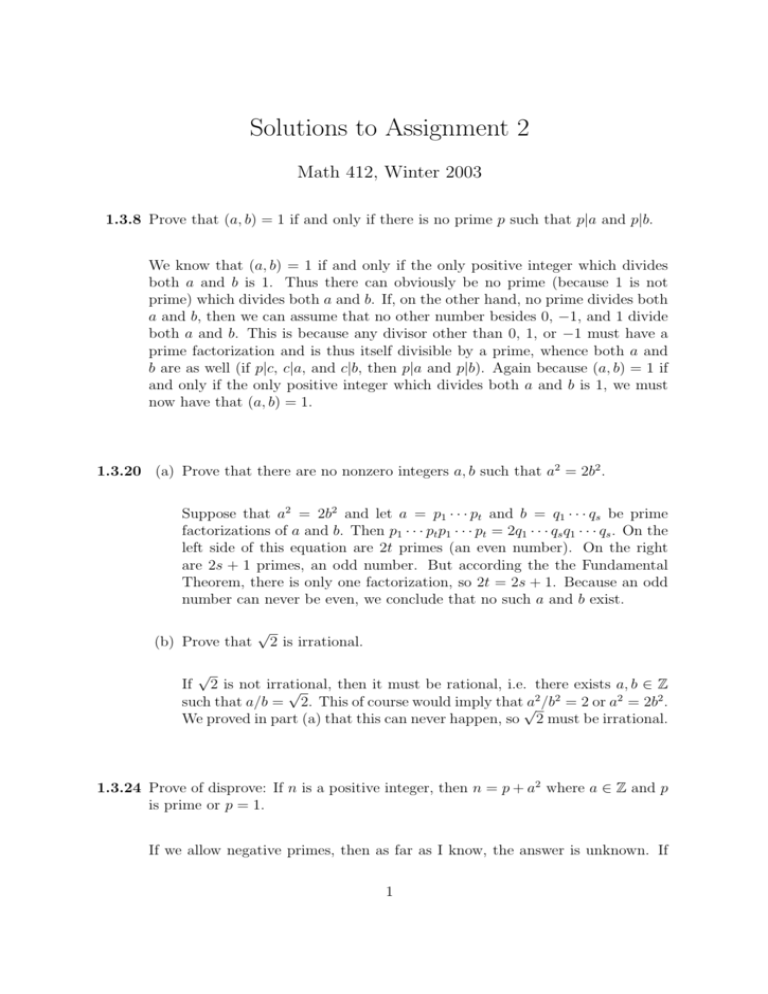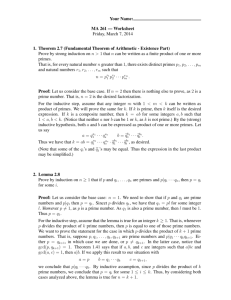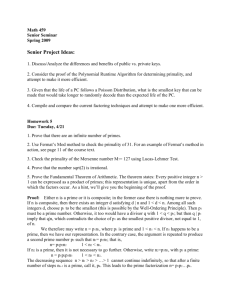Solutions for Homework 2
advertisement

Solutions to Assignment 2
Math 412, Winter 2003
1.3.8 Prove that (a, b) = 1 if and only if there is no prime p such that p|a and p|b.
We know that (a, b) = 1 if and only if the only positive integer which divides
both a and b is 1. Thus there can obviously be no prime (because 1 is not
prime) which divides both a and b. If, on the other hand, no prime divides both
a and b, then we can assume that no other number besides 0, −1, and 1 divide
both a and b. This is because any divisor other than 0, 1, or −1 must have a
prime factorization and is thus itself divisible by a prime, whence both a and
b are as well (if p|c, c|a, and c|b, then p|a and p|b). Again because (a, b) = 1 if
and only if the only positive integer which divides both a and b is 1, we must
now have that (a, b) = 1.
1.3.20 (a) Prove that there are no nonzero integers a, b such that a2 = 2b2 .
Suppose that a2 = 2b2 and let a = p1 · · · pt and b = q1 · · · qs be prime
factorizations of a and b. Then p1 · · · pt p1 · · · pt = 2q1 · · · qs q1 · · · qs . On the
left side of this equation are 2t primes (an even number). On the right
are 2s + 1 primes, an odd number. But according the the Fundamental
Theorem, there is only one factorization, so 2t = 2s + 1. Because an odd
number can never be even, we conclude that no such a and b exist.
(b) Prove that
√
2 is irrational.
√
If 2 is not irrational,
then it must be rational, i.e. there exists a, b ∈ Z
√
such that a/b = 2. This of course would imply that√
a2 /b2 = 2 or a2 = 2b2 .
We proved in part (a) that this can never happen, so 2 must be irrational.
1.3.24 Prove of disprove: If n is a positive integer, then n = p + a2 where a ∈ Z and p
is prime or p = 1.
If we allow negative primes, then as far as I know, the answer is unknown. If
1
one does not allow negative primes, then 34 gives a nice counter example.
34
34
34
34
34
34
6=
6
=
6
=
6
=
6
=
6
=
p + 0 because 34 is not prime,
p + 1 because 33 is not prime,
p + 4 because 30 is not prime,
p + 9 because 25 is not prime,
p + 16 because 18 is not prime, and,
p + 25 because 9 is not prime.
We can stop here because using larger squares would require negative primes.
2.1.14 If a ≡ 2 (mod 4), prove that there are no integers c and d such that a = c2 − d2 .
If a ≡ 2 (mod 4), then there is a t ∈ Z such that a − 2 = 4t. Now 2|4 and
2|2, so 2|a. If there exists c, d ∈ Z such that a = c2 − d2 , then this means
that 2|(c2 − d2 ). Factor c2 − d2 as (c − d)(c + d). Because 2 is prime, it must
divide either (c + d) or (c − d), which means that one of them must be even.
But if c + d is even, then so is c − d (either c and d are both even, or they
are both odd, and in both cases c − d must be even as well). If c − d is even,
then we may similarly conclude that c + d is even. This means that 2|(c + d)
and 2|(c − d), or that 4|(c + d)(c − d) = c2 − d2 . We conclude that 4|a. This
gives a contradiction, however, because if 4|a, then 4 must divide 2 (recall that
a − 4t = 2). We conclude that no such c and d exist.
2.1.20 If [a] = [1] in Zn , prove that (a, n) = 1. Show by example that the converse
may be false.
If [a] = [1] in Zn , then a ≡ 1 (mod n), that is, there exists a t ∈ Z such that
a − 1 = tn. We proved in class that there are u, v ∈ Z such that ua + vn = 1
if and only if (a, n) = 1. Since u = 1 and v = −t do the trick (a − tn = 1 from
above), we conclude that (a, n) = 1.
Note, on the other hand, that (2, 3) = 1, but [2] 6= [1] in Z3 because 2 6≡
1 (mod 3), i.e., 2 − 1 = 1 is not a multiple of 3.
2.1.28 Prove or disprove: If c ≡ a (mod r) and c ≡ b (mod s), then a ≡ b (mod (r, s)).
2
Given the conditions outlined above, we have that there exist m, n ∈ Z such
that c − a = nr and c − b = ms. Thus a − b = c − nr − (c − ms) = −nr + ms.
Because (r, s) divides both r and s, it divides −nr + ms, and hence (r, s)|a − b.
That simply means that a ≡ b (mod (r, s)) as required.
ApB.16 List all the subsets of {1, 2}. Do the same for {1, 2, 3}, and {1, 2, 3, 4}. Make a
conjecture as to the number of subsets of an n-element set.
Subsets of {1, 2}: φ, {1}, {2}, {1, 2}.
Subsets of {1, 2, 3}: φ, {1}, {2}, {3}, {1, 2}, {1, 3}, {2, 3}, {1, 2, 3}.
Subsets of {1, 2, 3, 4}: φ, {1}, {2}, {3}, {4}, {1, 2}, {1, 3}, {1, 4}, {2, 3}, {2, 4},
{3, 4}, {1, 2, 3}, {1, 2, 4}, {1, 3, 4}, {2, 3, 4}, {1, 2, 3, 4}.
In the above cases there are 4 = 22 , 8 = 23 , and 16 = 24 , so I conjecture that a
set of n elements has 2n subsets. (This conjecture is, in fact, true).
ApB.28 (a) Let F : B → C and g : C → D be functions such that g ◦ f is injective.
Prove that f is injective.
Suppose that f is not injective. Then there exist a, b ∈ B, a 6= b, such
that f (a) = f (b). Give the name c to the image of a and b in C (i.e., let
f (a) = f (b) = c). Then (g ◦ f )(a) = g(f (a)) = g(c) = g(f (b)) = (g ◦ f )(b),
a contradiction because g ◦ f is injective.
(b) Give an example of the situation in part (a) in which g is not injective.
Suppose that B = R+ (the set of positive real numbers), C = D = R,
f : R+ → R is defined by f (r) = r, and g : R → R is defined by g(r) = r2 .
Note that g is not injective because g(−1) = g(1) = 1. Suppose that
r, s ∈ R+ , and g(f (r)) = g(f (s)). Then r2 = s2 and taking the square root
of both sides, r = s (we don’t have to worry that actually −r = s, that is,
that we took the wrong square root, because both r and s are positive).
Because r = s is exactly what we needed to show, we conclude that g ◦ f
is injective.
ApC.4 Let r be a real number, r 6= 1. Prove that for every integer n ≥ 1, 1 + r + r2 +
n −1
.
r3 + · · · + rn−1 = rr−1
3
Let P (n) be the statement that 1 + r + r2 + r3 + · · · + rn−1 =
prove, using induction, that P (t) is true for all n ≥ 1.
Note that P (1) is the statement that 1 =
r 6= 1.
r 1 −1
,
r−1
r n −1
.
r−1
We will
which is obviously true when
So suppose that for some t > 1, the statement P (t) is known to be true. Our
goal is to show that P (t + 1) must be true. Because P (t) holds, we know
t −1
that 1 + r + r2 + r3 + · · · + rt−1 = rr−1
. Add rt to both sides to obtain:
t
t
t
t
−1
−1
−1
1 + r + r2 + r3 + · · · + rt−1 + rt = rr−1
+ rt . Of course, rr−1
+ rt = rr−1
+ (r−1)r
=
r−1
r t −1+r t+1 −r t
r t+1 −1
2
3
t−1
t
= r−1 . Thus we see that 1 + r + r + r + · · · + r
+r =
rr−1
r t −1
rt+1 −1
t
+ r = r−1 , that is, that P (t + 1) is true. By induction we conclude that
r−1
P (n) is true for all n ≥ 1.
ApC.12 True of false: n2 − n + 11 is prime for every nonegative integer n. Justify your
answer.
This is not true. The smallest positive counter example is n = 11. Here
112 − 11 + 11 = 112 and 112 is not prime. The answer of smallest magnitude is
n = −10. In this case (−10)2 − (−10) + 11 = 121 = 112 .
4









